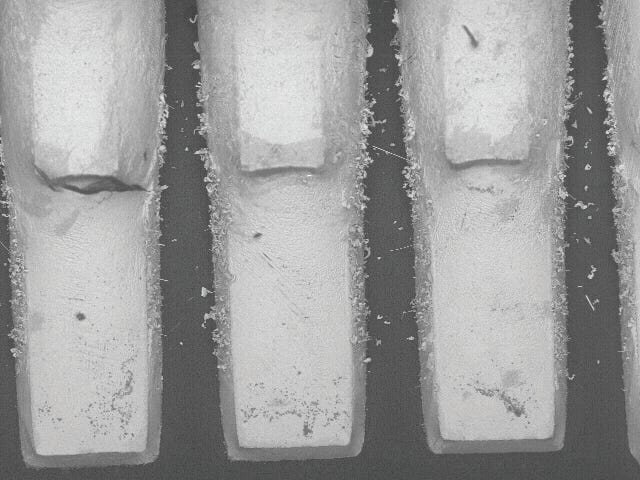New tin-based solder alloys are poised to rise dramatically in electronics manufacturing as OEMs modify their supply chain and manufacturing efforts to comply with the Restriction of Hazardous Substances (RoHS) directive imposed by European Legislation. The law forces many medical device manufacturers to eliminate a number of hazardous substances, such as lead, from their products by July 2014.
August 20, 2013
By: Simin Bagheri
At the moment, RoHS only affects OEMs planning to sell their devices in Europe, but with similar legislation on the way for North America, every manufacturer should begin to comply with the directive and remove hazardous materials from their manufacturing practices. Manufacturers not selling in Europe will also be affected because their part suppliers may choose to only provide unleaded versions of their products. This limitation is a trend that has already affected products in the aerospace and defense sectors.
Tin-based alloys are relatively low-cost, readily available, and have high electrical conductivity. However, they do have disadvantages. Due to the susceptibility of spontaneous growth of small filaments known as tin whiskers, the use of new tin-based alloys can result in serious reliability risks in medical devices. These filaments can produce short circuits in a variety of electronic components, which can cause product failures.
Avoiding tin whiskers through component selection is not feasible, they can grow from the tin-rich solder alloys used to assemble RoHS-compliant electronic products as well as from solderable parts coated with tin finishes. Tin whisker formation and growth is not only a supply chain issue, but also an important overall manufacturing concern. It is affected by component plating quality and ionic cleanliness levels in addition to electronic circuit board processing materials.
The issue is especially important for medical device manufacturers because of the extended life cycle of medical devices and the potential safety threat to patients. These devices are often critical for hospitals and healthcare centers, which means medical device manufacturers that create highly complex devices must put processes in place to mitigate and protect against tin whiskers.
Risk Mitigation
Medical device OEMs should ensure that their contract manufacturers have expertise in handling the risks associated with tin whiskers and are familiar with RoHS compliance best practices on a global level. Tin whisker risk mitigation should be part of every compliance plan, starting at the design and prototyping phase.
Tin whisker-related field failures date back many years in the medical device industry. On example is when FDA recalled several models of a heart pacemaker in 1986, which was attributed to the growth of tin whiskers from the tin-plated cases of the pacemaker’s crystal component. An electrical bridge between the crystal and its case caused a risk of shut down. Current knowledge and risk mitigation approaches would have led to an alternative to tin-plating in this application.
|
The growth of tin whiskers, as depicted above, can be hazardous in electronic devices, causing short circuits that potentially lead to device failure. Photo courtesy of Celestica and BAE. |
Before a medical device is manufactured, OEMs need to determine the threat level that tin whiskers pose to the finished product, and what changes can be made to mitigate those risks. For devices further down the line in production, manufacturers need to evaluate the feasibility of retrofitting existing product designs to account for the problem of tin whiskers. OEMs, with the help of their suppliers, should create a proven testing plan and a strategy to protect against potential liabilities.
Medical device makers rely on suppliers to provide them with parts that meet requirements. However, these components need to be evaluated and selected based on their field application. A strategic partner should help manufacturers navigate their supply base to ensure that the components they use won’t increase the risk and potential impact of tin whiskers.
A comprehensive risk reduction program requires the knowledge gained from extensive environmental testing to determine the propensity and severity of the problem in specific devices. This includes a database for whisker growth modeling, evaluation of the extent of conformal coating coverage at the whisker scale, and, if necessary, the development of improved coating application methods.
An overall risk assessment and reduction plan, supply chain assessment, and manufacturing best practices for avoidance are other necessary aspects of the program, as is current and in-depth knowledge of the findings of ongoing research and standards development projects. The program culminates in validation of the selected mitigation techniques from custom-designed laboratory assessments.
Managing the reliability risks presented by tin whisker formation is a critical challenge for the medical device manufacturing industry. Given the high reliability requirements of medical devices, OEMs must ensure their strategic partners can assess the risks of tin whiskers and implement risk mitigation tactics to combat growth.
Simin Bagheri is the customer engagement lead for the engineering services division Celestica HealthTech (Toronto). Her research has been focused on evaluating the thermal fatigue reliability and mechanical properties of a series of new generation lead-free alloys in collaboration with some of Celestica’s customers and global suppliers. Prior to joining Celestica, Simin was as a technology engineer in the global technology group at AMP Inc. Simin holds a master of applied science degree in metallurgy and materials science engineering from the University of Toronto. Reach her at [email protected].
You May Also Like



